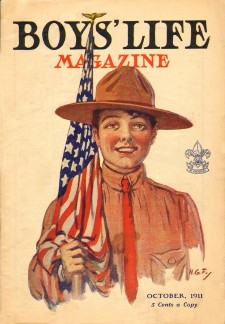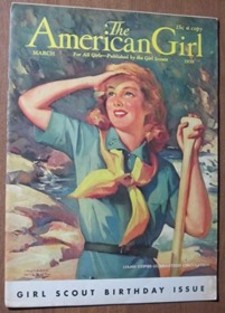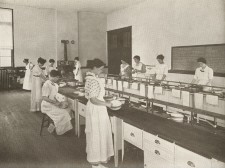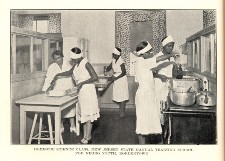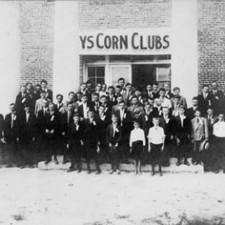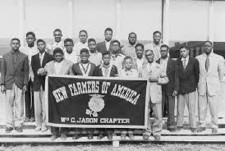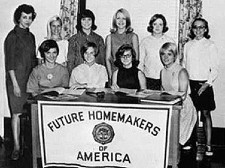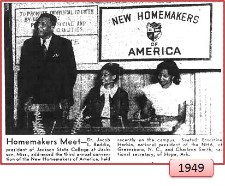In February 1980, President Jimmy Carter issued the first Presidential Proclamation declaring the Week of March 8th, 1980 as National Women’s History Week. This week was later extended to cover the entire month of March. Every year March is designated Women’s History Month by Presidential proclamation. The month is set aside to honor women’s contributions to American history.

We recently celebrated Black History Month. This is an annual celebration of achievements by African Americans and a time for recognizing their central role in U.S. history. Since 1976, every U.S. president has officially designated the month of February as Black History Month.
Next month, on April 5, we can also celebrate National New Farmers of America (NFA) day (so stay tuned).
In recognition of Women’s History Month and the recently celebrated Black History Month (and the future NFA Day) we are looking at the past in this issue of the Friday Footnote in order to look ahead. As you read this Footnote ask yourself “Is the past the way it should be in the future?”
We welcome back Dr. Jim Connors from the University of Idaho as the guest editor of this column. Take it away Dr. Connors.
Introduction
In many ways, men and women have often lived separate lives. While men and women were expected to marry and raise a family, they very often had very different interests and responsibilities. In the very early stages of formal education, men and women were educated separately and trained for different jobs in life.
This Friday Footnote will compare the different paths men and women took through the educational system and life in general. I begin with a story. When I was a new vocational agriculture teacher in 1984, my wife and I were invited by a farmer in my community to a small dinner with a Farm Bureau group. We received a warm welcome and had a very pleasant dinner at the home of a local farmer. However, after dinner, the women began to clean and went off to discuss “women’s things” in the kitchen. While the men stayed in the dining room to discuss “men’s agricultural business.” Even in the 1980s, men and women were still living very separate lives.
Community Groups
Just as the Farm Bureau had separate activities for men and women, other community groups were also segregated by gender. Churches often had both mens’ clubs like the Knights of Columbus in the Catholic Church, and women’s clubs. It was similar with sports and athletics. Today most people couldn’t even tell you what YMCA and YWCA stands for. They just know the “Y” is a local gym in their community. The Young Men’s Christian Association was formed in 1844 in London to help young men develop a healthy body, mind, and spirit. The idea quickly expanded worldwide and came to the United States in 1851. Similarly, the Young Women’s Christian Association (YWCA) was formed in 1855.
 |
 |
Youth Organizations
With the turn of the century, a growing need for structured youth organizations was recognized. Just as the YMCA and YWCA were formed for young men and women, the Boy Scouts of American and Girl Scouts of America were formed to help young boys and girls grow into productive citizens. The Boy Scouts was formed in England by Lord Robert Baden Powell in 1908 when he published the first official handbook for Boy Scouts titled Scouting for Boys. The movement quickly expanded to America with the founding of the Boy Scouts of America in 1910.
Once the Boy Scouts of America became organized, the girls wanted to join in on the outdoor experiences. The Girl Scouts of America was founded in Savannah, Georgia on March 12, 1912. Below are pictures of both the Scouting for Boys and Scouting for Girls handbooks. As the organizations grew, they started to publish magazines for their members. The Boy Scouts published Boys Life while the Girl Scouts published the American Girl magazine.
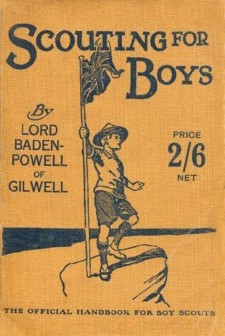 |
 |
|
|
|
Land Grant Universities
It was in the mid to late 19th century that land grant universities were established in each state. In the early decades of land-grant colleges most men and women enrolled in traditional areas of study for their respective gender. Men tended to enroll in the agricultural sciences including animal science, plant science, soil science, or forestry. While some early agricultural college graduates were women, they tended to focus more on careers targeted toward the female gender. These careers included education/teaching, nursing, and homemaking. What we commonly know today as Family and Consumer Sciences started as Domestic Science, then changed to Home Economics. Women enrolled in domestic science courses often studied cooking, homemaking, sewing, cleaning, textiles and fashion.
Land-grant colleges and universities also offered students the opportunity to join fraternities and sororities. Men with agriculture experience were often recruited to join either Alpha Gamma Rho (AGR) or Farmhouse (FH) fraternity. The women interested in agriculture could join the Sigma Alpha (SA) Honorary Sorority.
As many know the 1862 Morrill Land-Grant Act provided federal funds to create one land-grant college in each state. However, most of these colleges did not enroll “negro” students in the late 1800s. As a result, the 1890 Morrill Land-Grant Act provided federal funds to establish land-grant colleges for black students primarily in the south eastern part of the country. So not only were men and women often educated separately and in different subjects, but white students and black students were also segregated into different land-grant colleges entirely.
Just as in 1862 land-grant colleges, the 1890 colleges offered agricultural science courses and domestic science courses. The pictures below show domestic science courses for women. One picture shows white girls in a cooking class at East Carolina University. The other picture shows black girls in a domestic science class at the New Jersey State Manual Training School for Negro Youth in Bordentown, NJ.
|
|
|
Agriculture Clubs
If you are a regular reader of history or these Friday Footnotes, you probably know that the forerunner of the 4-H youth clubs were segregated youth clubs for boys and girls. Just as in other areas discussed above, boys’ interests often related to production agriculture, while girls focused more on the home. Boys would work with their fathers doing farm chores while the girls tended to help their mothers with the chores in the house.
Prior to the development of 4-H clubs for both boys and girls, there were Corn Clubs for boys and Canning Clubs for girls. The boys would meet and discuss improved agricultural practices for increasing crop yields. They would then be given new varieties of seed corn to plant one acre of ground. Boys would care for the acre of corn and compete for the highest yield within their club or state. At the same time, the girls would meet to discuss ways of improving the home including growing healthier foods in the garden and serving more nutritious meals for the farm family. Girls would plan and tend to a garden including the growing of tomatoes. They would then get together to safely can the tomatoes for long-term storage and use throughout the winter months.
|
|
|
The separate boys and girls clubs eventually led to the development of 4-H clubs in 1902. While 4-H clubs included both boys and girls, as in other areas, they often focused their youthful energy on production agriculture projects and domestic science projects respectively. Boys often raised crops or livestock for show at local county fairs. Girls often showed garden vegetables, crafts, sewing, canning, or food projects at the fairs.
In the South, the 4-H clubs were segregated. The image below is the North Carolina 4-H Club magazine for African American 4-H clubs (circa 1939).
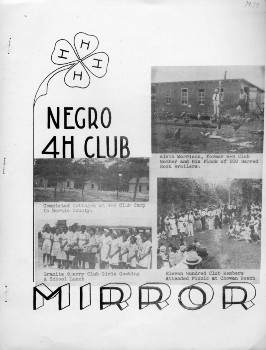
Future Famers and Homemakers of America
The Future Farmers of America (FFA) was established in 1928 for boys studying vocational agriculture in public schools. However, that is not entirely correct. The FFA was for “white boys” studying vocational agriculture. A separate organization, the New Farmers of America (NFA) was formed in 1935 for black boys who were studying vocational agriculture in segregated schools in southern states. As a result of the de-segregation of America’s public schools after the famous Brown vs. Board of Education case in 1954 and the passage of the Civil Rights Act in 1964, the FFA and NFA organizations merged in 1965.
Both the FFA and NFA were for boys interested in agriculture. But what about girls? What organizations were available to girls? While the boys were studying agriculture in schools, most of the girls were enrolled in home economics classes to learn how to cook, sew, and maintain a household. In 1945, home economics leaders met to form the Future Homemakers of America (FHA) for girls studying “Home Ec” in schools. But the girls faced the same situation as the boys, white girls and black girls had separate organizations. The same year that the FHA was formed, 1942, the New Homemakers of America (NHA) was formed for black girls studying home economics.
|
|
|
|
|
|
While the boys were members of the FFA and the girls were members of the FHA, the two organizations didn’t really compete against one another. In fact, FFA and FHA cooperated on many activities. Schools that offered both organizations often had joint activities including community service projects, dances, and other social events. Chavez (1953) described how some chapters had the FHA girls prepare the menu and food for the FFA Father-Son Banquet. Chavez suggested that the Agriculture teacher could teach home economics classes about meat cuts or simple home repairs. The author also suggested that the Home Economics teacher could teach the agriculture classes units on nutrition, meal planning, food preparation, furniture selection or home decorations.
Before girls were admitted into the FFA in 1969, many chapters selected a girl to serve as the FFA Sweetheart for the chapter. In many cases, the girl would be selected from the ranks of the FHA membership in the school. Conversely, many FHA chapters would select an FHA Beau or King from the boys in the FFA (Casey & Moore, 2013).
Below is a synopsis of the different programs and organizations for males and females.
Male and Female Programs and Organizations
| Group | Males | Females |
| Agricultural Clubs | Boys Corn Clubs | Girls Canning Clubs |
| Beauty Contests | FFA Sweethearts | FHA Beau or King |
| 4-H | Boys agricultural projects | Girls home economics projects |
| Greek Life | Farmhouse Fraternity
Alpha Gamma Rho Fraternity |
Sigma Alpha Sorority |
| Land Grant Universities | Agricultural and Natural Resource Sciences | Domestic Science
Home Economics Family & Consumer Sciences |
| Black Youth | New Farmers of America | New Homemakers of America |
| White Youth | Future Farmers of America | Future Homemakers of America |
| Scouting | Boy Scouts of America (BSA) | Girl Scouts of America (GSA) |
| Athletics | Young Men Christian Association (YMCA) | Young Women’s Christian Association (YWCA) |
| Religious Groups | Men’s Clubs
Knights of Columbus (Catholic) |
Women’s Clubs |
Obviously, there have been many changes in society and organizations over the past century. Men and women now have the opportunity to study whatever subjects they are interested in and join whatever organizations excite them. Even the Boy Scouts of America have rebranded themselves into Scouts BSA and opened their membership to girls interested in outdoor pursuits. In December 2020, 15-year old Lily Morse of Los Angeles, became the first female Eagle Scout recipient, joining the over 2.5 million boys who have earned the Eagle Scout rank since 1912.
In 2020, schools and organizations offer programs for both men and women. Female enrollment in land-grant universities colleges of agriculture has increased dramatically. No longer do men only focus on production agriculture and women focus on family and consumer sciences. While fraternities and sororities still limit membership for obvious reasons, most organizations recruit both men and women into membership. In addition, the Minorities in Agriculture and Natural Resources and Related Sciences (MANRRS) organization offers programming for minorities and diverse populations of students studying in land-grant universities. The FFA and Family, Career, and Community Leaders of America (FCCLA) are open to boys and girls of any race, creed, or color. We no longer have separate youth organizations for boys and girls.
These changes have all improved the educational and leadership opportunities for students. It no longer matters if you are black, white, male, female, or another race or gender, agricultural education is open to all. Diversity makes all of us stronger. It clearly is a bright future for everyone involved in the agriculture profession.
Suggested Activities:
- Identify a person of color who is involved in agriculture in your community. Interview that individual to learn about their life story and agricultural experiences and how they are different from your own personal experiences.
- If your school has both an FFA and FCCLA chapter, meet to identify ways of cooperating and brainstorm possible joint events or activities.
References:
Bass, R. E. (1947, July). Virginia F.F.A. – F.H.A. camp. The Agricultural Education Magazine, 20(1), 7.
Casey, J. & Moore, G. (2013). The FFA sweetheart: Past, present, and future (?). Proceedings of the American Association for Agricultural Education Research Conference.
Chavez, D. J. (1953, November). A joint program of work for FFA and FHA? The Agricultural Education Magazine, 26(5), 113.
Cooperative undertaking F.F.A. – F.H.A. in Tennessee (1947, November). The Agricultural Education Magazine, 19(10), 198.
Moore, G. (2018, November 16). The FFA sweetheart. The Friday Footnote. Retrieved from: https://footnote.wordpress.ncsu.edu/2018/11/16/the-ffa-sweetheart-11-16-2018/

